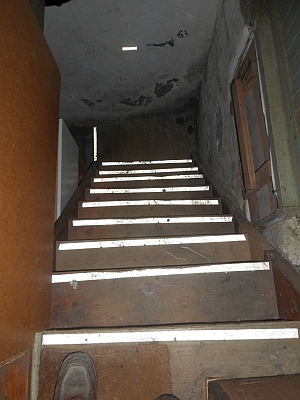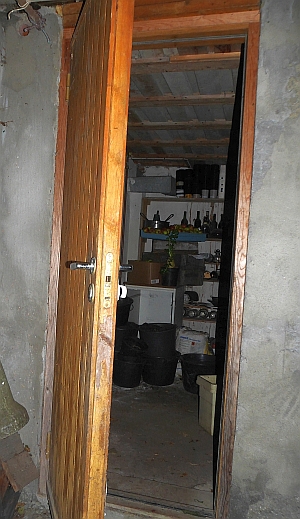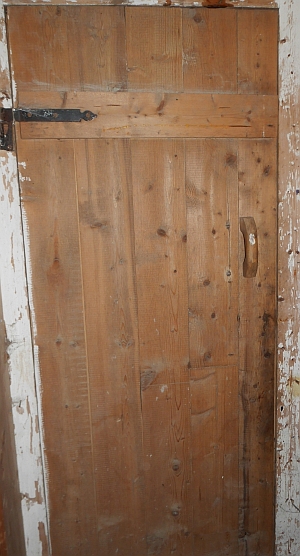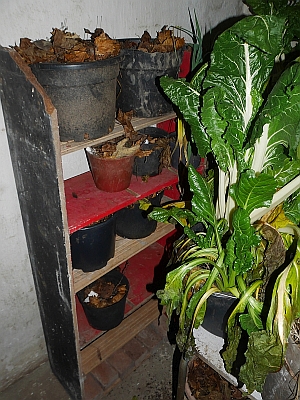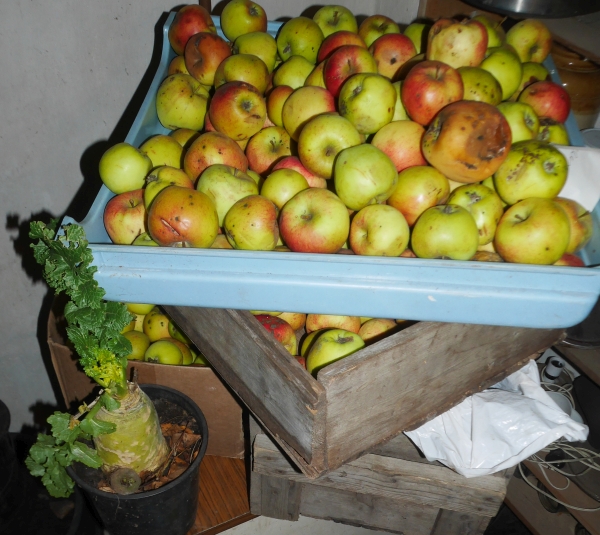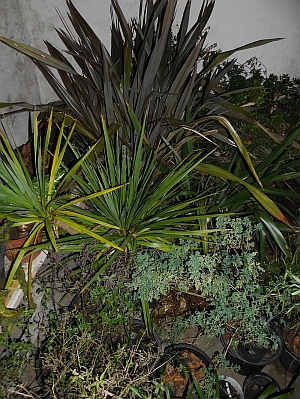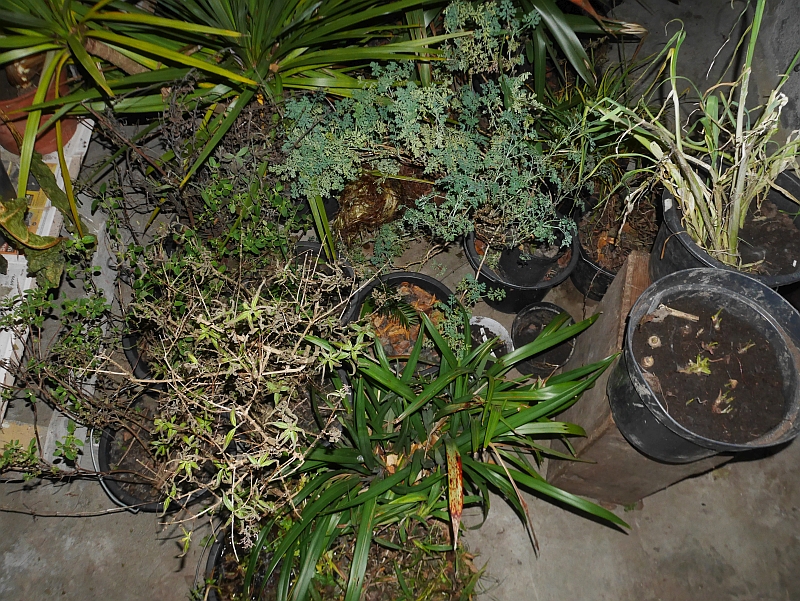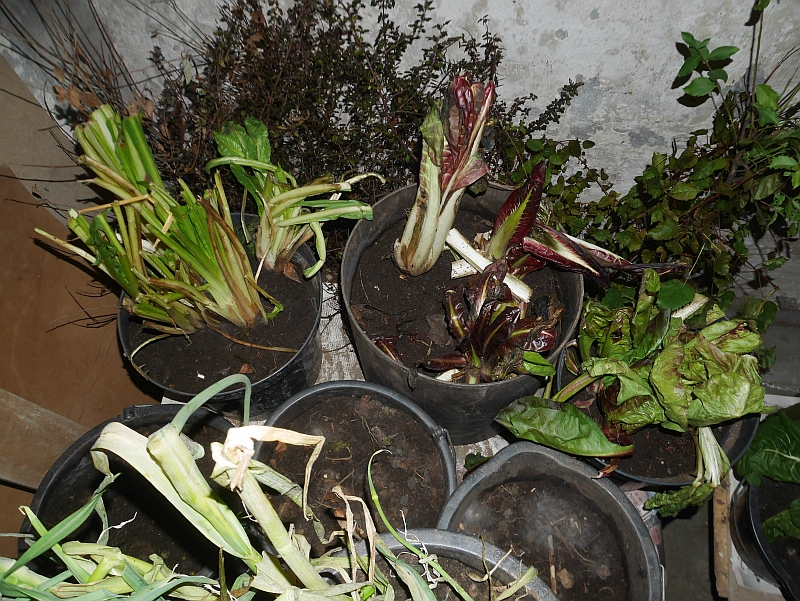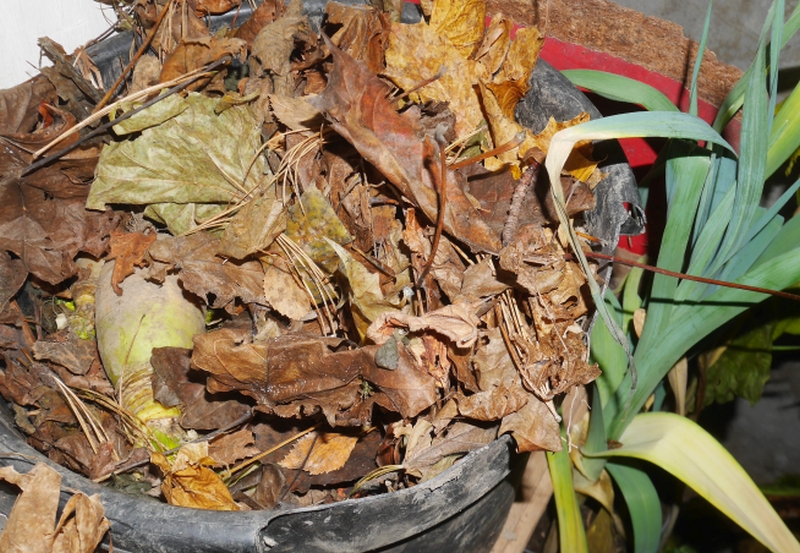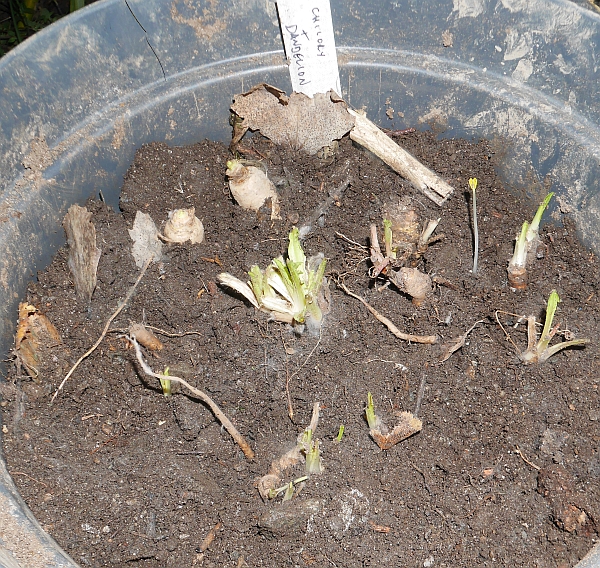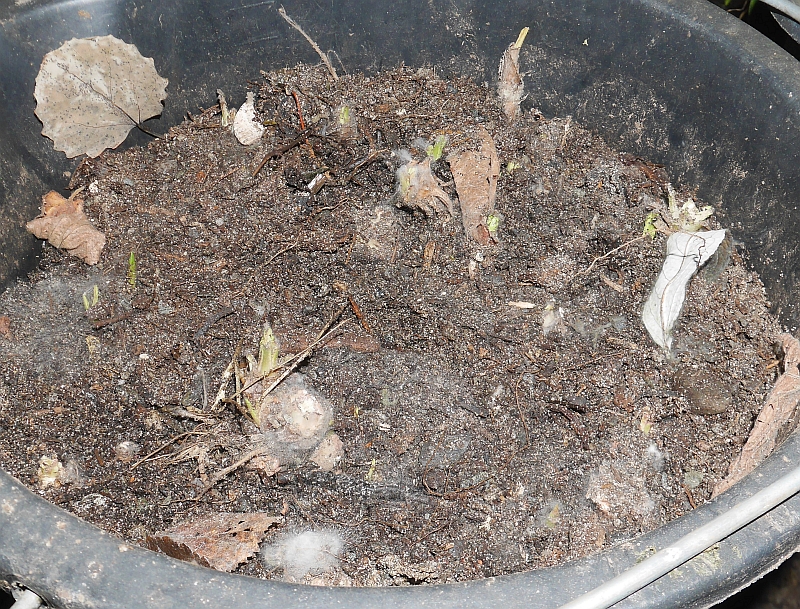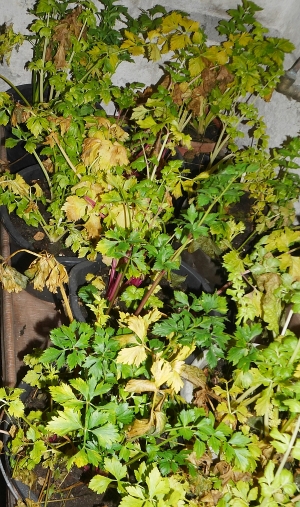Wonderful rain on the balcony (aka zone 0.5) with oca (Oxalis tuberosa), 9 varieties of lettuce (salat), tomato “42 days” , dill, coriander, toothache pant (Spilanthes), shungiku / kronkrage and lots of celery (around the corner). The large bucket in the corner contains burdock providing seed fot goldfinches (stillits) and greenfinches (grønnfink) in winter (a living bird feeder!)
Tag Archives: Burdock
Soba perennial veg stir-fry
This week’s perennial veg stir-fry with soba (buckwheat noodles), Japanese style contained the following (roughly left to right in the picture):
Nettles / stornesle (Urtica dioica)
Burdock / storborre roots (Arctium lappa); stored in the cellar
Wapato tubers (Sagittaria latifolia); stored in the cellar in water
Ramsons / ramsløk (Allium ursinum)
Caucasian spinach / stjernemelde (Hablitzia tamnoides)
Giant bellflower / storklokke (Campanula latifolia)
Himalayan water creeper (Houttuynia cordata) – reddish shoots
Sand leek / bendelløk (Allium scorodoprasum)
Garlic / hvitløk (Allium sativum)

Root hairs and burdock
I used some burdock / borre root (Arctium lappa) in an oriental stir-fry the other day. They’ve been stored in autumn leaves in the cold cellar since autumn and now with the temperature increasing, the roots had developed many white root hairs. Their function is to dramatically increase the root surface area and hence interface with the soil, and hence enhancing the absorption of water and minerals.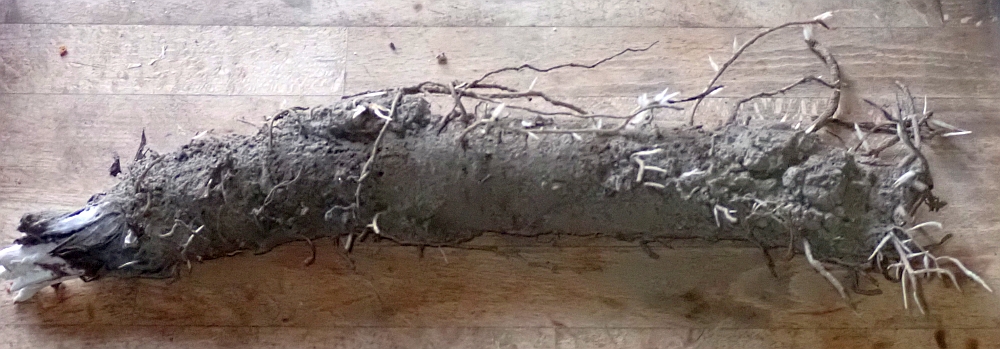

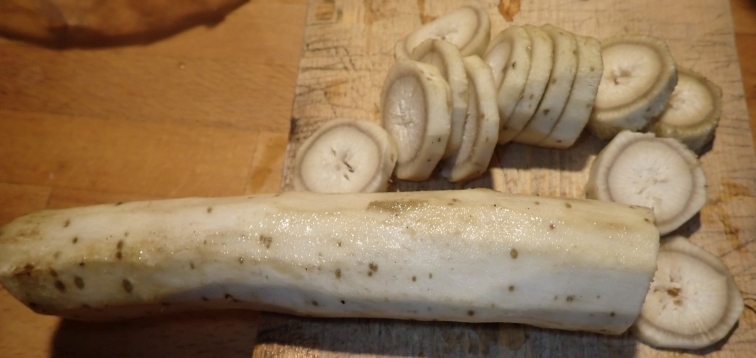
A tour of the Edible House cellar!
I probably wasn’t aware, when we bought the house 40 years ago next year, how important the cold cellar under the house would be. It is largely unimproved since we moved here. It has allowed us to be self-sufficient in all our own fresh vegetables, root crops and fruit with minimal pre-processing. There are 4 full size rooms in the cellar which are kept dark (there are small windows which are kept covered) and without heating. Even though it is relatively early in the winter, it is at the moment just about as cold as it ever gets down there thanks to the freezing temperatures since the end of October. First are some pictures of the stairs and doors. Below is another album of pictures of the vegetables in storage; explanation with the pictures!
Rhizo-bacalhau
We occasionally eat wild fish and bacalhau is a favourite made from Norwegian dried cod that can be found in supermarkets here. More or less anything goes in bacalhau (bacalao) and although most people make it in the same way – layers of potato, fish, tomato and onions, often with chili – the Portuguese have hundreds of ways of preparing baccalao (dried cod). Being self-sufficient, detailed recipes aren¨’t useful and we use whatever is available at the moment. Winter is the time for stored bulbs, corms, tubers, rhizomes, and taproots. See below the picture for yesterday’s baccalao ingredients with 14 home grown below surface storage organs plus some greens (I’m pretty sure nobody else had this version of the dish…ever!):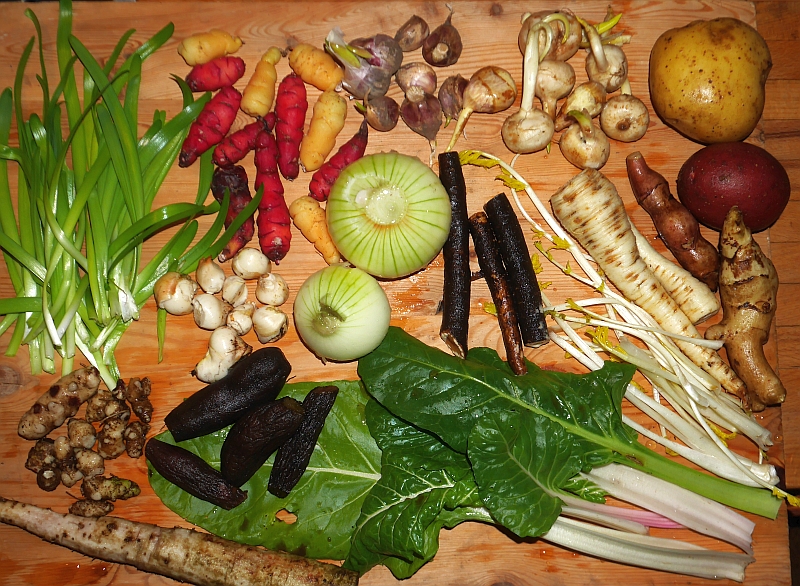
Oca (Oxalis tuberosa): yellow and red varieties
Garlic / hvitløk (Allium sativum)
Wapato (Sagittaria latifolia)
Potato / potet (Solanum tuberosum) – 2 varieties
Jerusalem artichokes / jordskokk (Helianthus tuberosus)
Parsnip / pastinakk (Pastinaca sativa)
Scorzonera / scorsonerrot (Scorzonera hispanica)
Common onion / kepaløk (Allium cepa)
Cacomitl (Tigridia pavonia)
Yacon (Polymnia sonchifolia)
Burdock / storborre (Arctium lappa)
Madeira vine (Anredera cordifolia)
Parsnip / pastinakk (Pastinaca sativa) shoots – had started shooting in the cellar
Leaf beets / bladbete (Beta vulgaris var. flavescens) – 3 varieties
Allium nutans (forced in the living room)
plus (not home grown) organic tomatoes, olive oil and olives
(I forgot the dandelion…will add tonight: we make enough that it lasts for several days….and the taste improves!)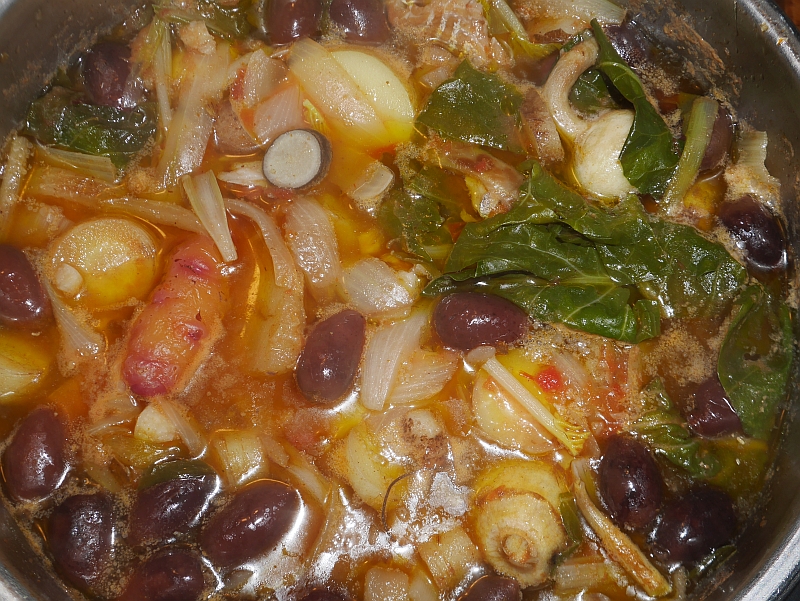
Xmas diversity from the rhizosphere
Presenting this year’s 30 rhizosphantastic Xmas vegetables, all roasted in the oven, served as every year in the last 40 with nut roast, bedecked with the following seeds / bulbils: alpine bistort / harerug (Polygonum viviparum), Himalayan balsam / kjempefringfrø (Impatiens glandulifera), evening primrose / nattlys (Oenothera biennis) and opium poppy (Papaver somniferum). The tubers are listed below the pictures.


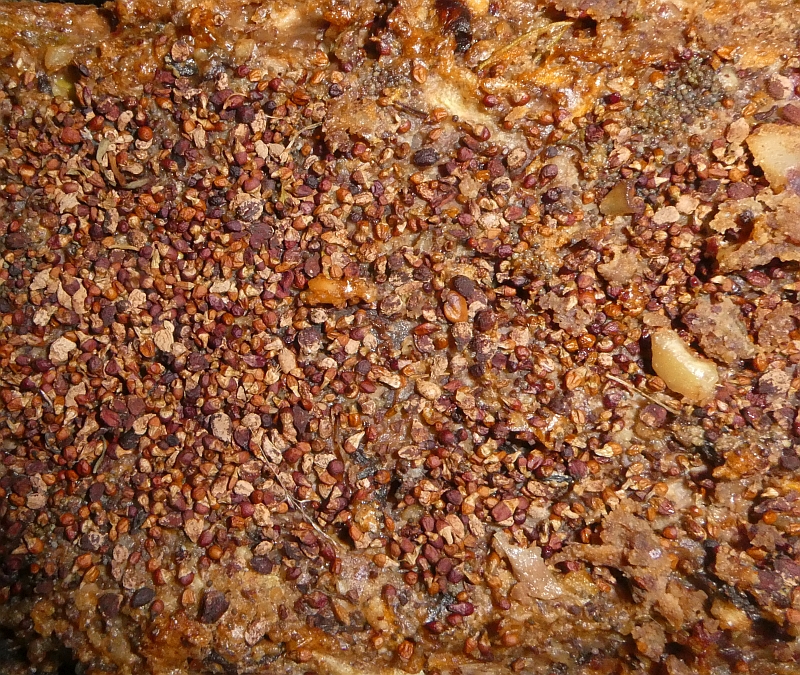
The 30 tubers, roots and rhizomes in the picture are:
Solanum tuberosum (potato / potet: 11 varieties)
Daucus carota (carrot / gulrot)
Oxalis tuberosa (oca: 2 varieties)
Arctium lappa (burdock)
Scorzonera hispanica (Scorzonera / scorsonnerot eller svartrot)
Tigridia pavonia (cacomitl)
Pastinaca sativa (parsnip / pastinakk)
Beta vulgaris (beetroot / rødbete)
Tropaeolum tuberosum (mashua)
Anredera cordifolia (Madeira vine)
Helianthus tuberosus (Jerusalem artichoke / jordskokk : 3 varieties)
Brassica rapa (turnip / nepe)
Brassica napus (swede / kålrot)
Dahlia (Dahlia / georginer)
Polymnia sonchifolia (yacon)
Sagittaria latifolia (wapato)
Allium cepa (onion)
Burdock harvest
I have a large bucket on the balcony where i grow greater burdock (Arctium lappa) for the birds, Both goldfinches (stillits) and greenfinches (grønnfink) eat burdock seed in winter and by growing the plants on the balcony I have close views of both species from where I’m typing this! Last year, the plants flowered and set seeds, they germinated en masse this spring, I thinned them and this was the harvest today. The largest roots and the smallest ones will be replanted in the spring. The others will be eaten in oriental stir-fries this winter.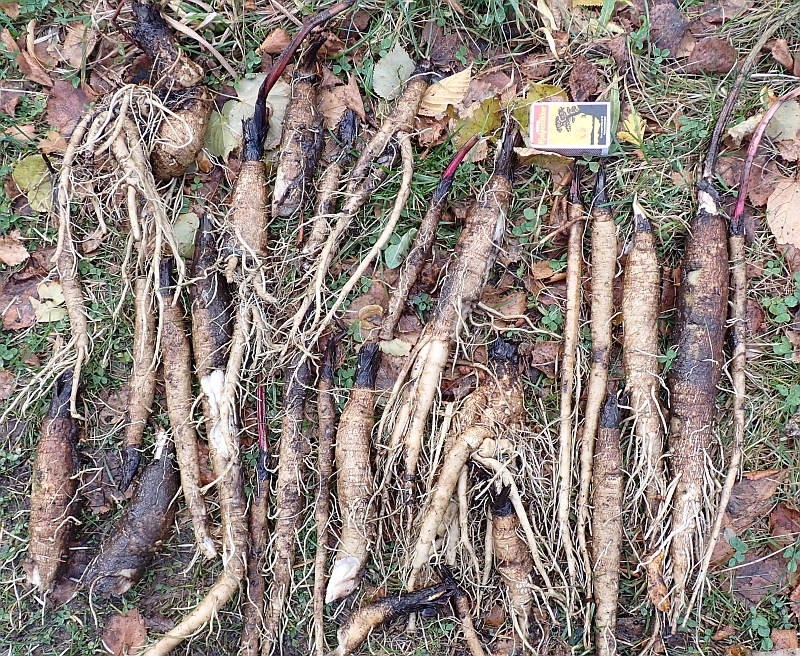
See also other burdock posts: https://www.edimentals.com/blog/?s=arctium
Natural bird food is best
I garden for the birds and other wildlife as well as myself and believe that bought bird food (sunflower seeds) is not necessarily a good thing as it’s imported and largely grown inorganically to the detrement of birds and other wildlife in the country of origin. My observations are that most bird species in our area prefer natural food (including grain in local fields) and several species never or seldom come to bird feeders. Others such as blackcap (munk) are reliant to a large extent on garden berries and fruit.
For these reasons, I put out purchased birdfood including homegrown grain and apples only when the whether is severe. Even here in the north where we have largely had subzero temperatures day and night since November, most birds seem to be finding plentiful natural food this winter. Today, greenfinches (grønnfink) and bramblings (bjørkefink) were feeding on rowan (rogn) berries, I noticed a blue tit (blåmeis) eating nettle seed, waxwings (sidensvans) were taking guelder rose (krossved), hawthorn (hagtorn) and rowan berries (films below), a blackcap was spotted eating one of the last apples still hanging on a tree, fieldfares (gråtrost) were eating hawthorn berries and, for only the second time I noticed goldfinches feeding on chicory (sikkori) seed before switching back to burdock (borre) seed. I grow both burdock and chicory for food and a bi-product of seed saving is that the birds get a share. There are also flocks of siskins (grønnsisik), crossbills (korsnebber) and pine grosbeaks (konglebit) feeding on spruce and pine seed, often in large flocks. Every evening there are maybe a thousand crows (hooded crows / kråke and jackdaws / kaie) that fly into the roost at Vikhammer, still finding grain during our short day in the snow-covered fields. There’s also a local flock of over 90 Canada Geese (Kanadagås) that are overwintering and still able to forage in the fields. There are thousands of wildfowl also on the fjord and I today noted a flock of 250 mallard (stokkand) duck resting in the bay below the house.
Bird feeders can also have negative impact on birds as disease can spread rapidly, such as salmonellosis in greenfinch and house sparrow.
Growing plants in our gardens to supply a greater proportion of winter food for our birds is something many of us can do, but it does mean leaving seed heads to deadhead until spring and encouraging wild plants such as nettles which have multiple uses for us and wildlife. It’s also not as easy as buying a bag of bird seed from the supermarket. Bird friendly plants can be planted in good view of the house. For example, I have a yew tree right next to my kitchen window which allows me to observe berry-eating species such as blackcap, waxwing, robin, fieldfare, redwing and blackbird to within 1m!
I think we should also consider delaying putting out commercial bird food until weather really is severe.
1. Waxwings in slow motion – notice what happens with the rowan berry in the second sequence in the first video:
2. Only the second time I’ve seen goldfinches on chicory:
3. Waxwings on guelder rose berries with bramblings
Burdock for goldfinches
I’ve written a series of articles in 3 parts “Fuglevennlige planter i hagen” (Bird friendly plants in the garden) for the magazine of our national bird society (NOF, now Birdlife Norge) called Vår Fuglefauna (Our Bird Fauna). The first part (6 pages) has already been published (the first two pages are shown below; deliberately blurred text (below).
My most successful plant (genus) supplying bird food in winter has been various species of burdock / borre (Arctium spp.). The oil rich seeds are very popular with goldfinches (stillits) and greenfinches (grønnfink). This autumn I cut a few plants growing in a different part of the garden and moved them in full view of my kitchen window which allowed me to film a flock of 11 goldfinches yesterday (see below). In the summer, the same plants are popular with various pollinators and for that reason also provide food for other insectivorous birds in summer.

The article will also be published for members of Norwegian Seed Savers’ guild for “Insect and Bird Friendly Plants” in a few months from now. This guild works focuses on plants that are beneficial for maintaining a garden rich in a diversity of insects and birds, whilst still providing food for us!
Goldfinches on the balcony
At last, a flock of 5 goldfinches were on my balcony feeding on burdock (borre) that I planted there two years ago in a large pot with the purpose of attracting them closer!

